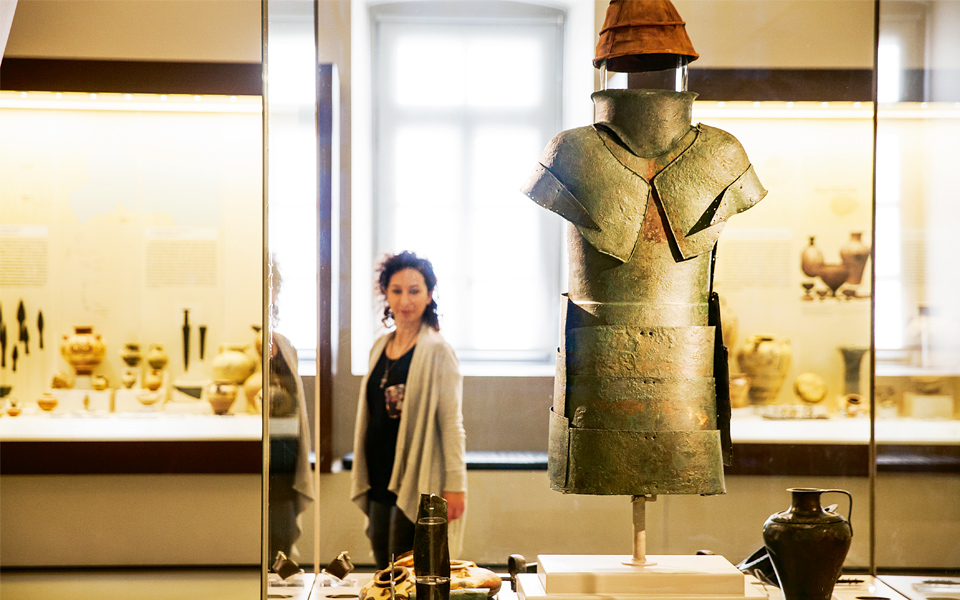The majority of visitors to Nafplio, eastern Peloponnese, usually focus on the city’s cosmopolitan side, enjoying coffee at its vibrant Syntagma Square, shopping along the main street, wondering around the surrounding cobbled alleys, and indulging in a giant-sized gelato at one of the town’s renowned ice cream parlors before heading on to the beach.
At sunset, tightly embraced couples, families and children stroll around the charming bay area enjoying views of the lighthouse, fishing boats, and the beautifully- lit Bourtzi fortress, standing on a rocky islet in the middle of the harbor.
Walking up the steps at Psaromahala, a former fishermen and merchant district stretching beyond Staikopoulou street visitors should definitely stroll through the alleys featuring listed buildings, multi-colored flower beds, and cats perched on rooftops as they soak in the sun.
Nafplio is definitely picturesque and can also be extremely romantic with a stroll, west of the port, along Arvanitia Promenade, the town’s pedestrianized seaside road. This route, running below rocky cliffs – where prickly pear cacti grow that become loaded with fruit in the summer – leads to Banieres beach, featuring an enclosed area as a swimming pool, where young children once trained in the past.
Towards the back, Panagitsa, a small church on the rock, known as the Santa Maria della Grotta during Venetian rule and which served as the town’s secret school (kryfo scholio) during Ottoman rule, offers an uninterrupted view of the Argolic Gulf. It is the perfect place to exchange vows of eternal love.
Once past the lighthouse, with the town in the rear, Palamidi, an eight-bastion fortress and an excellent example of Venetian fortification, is the symbol of the city. Nafplio’s revolt against Ottoman rule was launched from here.
But besides all the aforementioned, another less obvious feature of Nafplio is the town’s wonderful museums, which have plenty to offer visitors wishing to immerse themselves in art and history.
“Another less obvious feature of Nafplio is the town’s wonderful museums, which have plenty to offer visitors wishing to immerse themselves in art and history.”
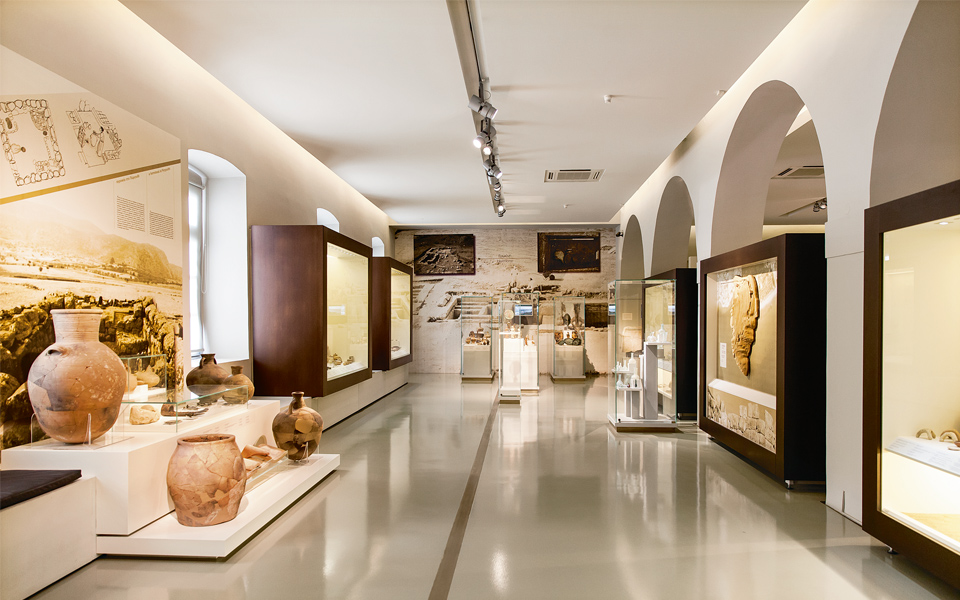
© Dimitris Vlaikos
ARCHAEOLOGICAL MUSEUM
This museum reopened in 2009 following renovation work conducted on the building. Located at the main square, it was built in 1713, during the second Venetian occupation, under the Naval Proveditore Augustine Sagredo, and was initially used as a warehouse before it served as barracks. As a museum, it nowadays hosts approximately 1,500 artifacts from the Prehistoric era to the Bronze Age. The museum’s new permanent collection – which includes rare finds from Franchthi cave located in southwest Argolida, as well as exhibits from the surrounding towns of Midea, Tiryns, and Assini – is displayed in an up to date manner .
The museum’s most emblematic piece, a bronze body armor discovered at the Mycenaean cemetery of Dendra and dated to the late 15th century BC, is exhibited on the second floor. It most likely belonged to a powerful Mycenaean ruler. The heavy armor is divided up in parts. Its assembly is demonstrated in a video accompanying the exhibit. The helmet features almost 40 wild boar teeth, symbolizing the fighter’s strength.
“Because of the body armor’s weight, we presume that it was not worn on a daily basis or during battles. These outfits were designed for official ceremonies, to greet dignitaries, or burial use. Its construction is exceptional, which means that workshops and great craftsmen must have existed in the area,” explained Alkistis Papadimitriou, the museum’s director and curator of prehistoric and classical antiquities in Argolida.
Also look out for the 7th century BC clay masks, apotropaic symbols from the Tiryns palace, intended to ward off evil, as well as a mirror from the necropolis of ancient Hermione, estimated to have been custom-designed between 490-470 BC. It was discovered in 1994.
Info | Syntagma Square • Tel. (+30) 27520.275.02 • Operating Hours: 08:00-15:00 • Closed on Mondays
“The museum’s most emblematic piece, a bronze body armor discovered at the Mycenaean cemetery of Dendra and dated to the late 15th century BC”
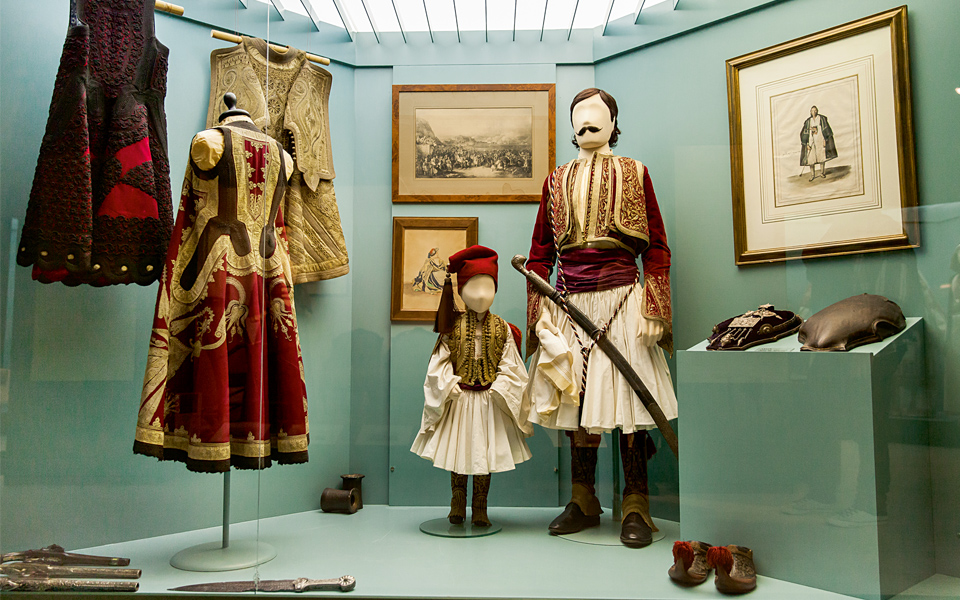
© Dimitris Vlaikos
“In 1981, the foundation received a European Museum of the Year award. Its collection numbers 45,000 items as well as nearly 12,000 book titles.”
PELOPONNESIAN FOLKLORE FOUNDATION
“VASSILIOS PAPANTONIOU”
The wealth of the Peloponnesian Folklore Foundation’s collection was reflected in an event hosted by the Benaki Museum in Athens in 2004 as part of the Cultural Olympiad – a series of cultural events that had been staged as a prelude to the 2004 Athens Olympics.
Titled “Ptychoseis = Fold + Pleats: Drapery from Ancient Greek Dress to 21st Century Fashion,” the exhibition, the first major international fashion show to be held in Greece, included items from the Peloponnesian Folklore Foundation’s collection and explored the aesthetic qualities of drapery through selected ancient Greek sculptures and regional clothing from around the world, as well as creations by contemporary designers.
The foustanela, a traditional pleated men’s garment, was linked to the work of Issey Miyake and the robes of the Maasai tribes, while a connection was also made between the designs of John Galliano and ancient Greek statues.
The Peloponnesian Folklore Foundation, which was founded in 1974 by folklorist and set designer Ioanna Papantoniou in memory of her father, was honored in 2013 by the Academy of Athens, a cultural institution, for its contribution to Greek culture.
In 1981, the foundation received a European Museum of the Year award. Its collection numbers 45,000 items as well as nearly 12,000 book titles. The foundation also regularly publishes studies concerning costume and folk culture.
Info | 1 Vas. Alexandrou & Sofroni • Tel. +30.27520.283.79 • Weekdays 09:00-14:30, Sundays 09:30-15:00
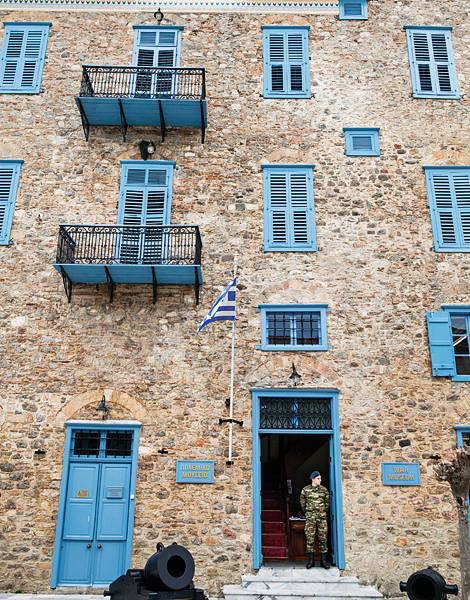
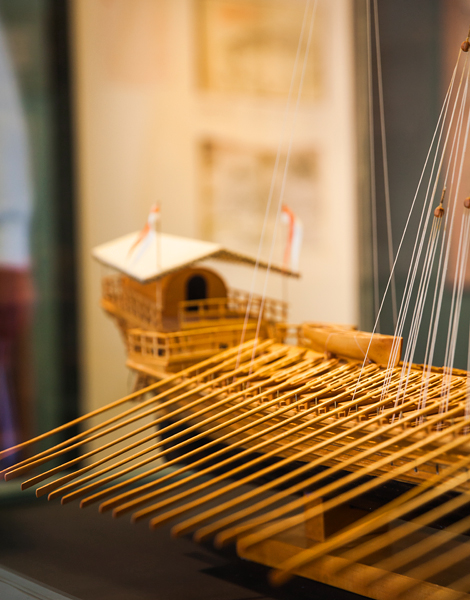
WAR MUSEUM
The War Museum may not rank as a leading priority for most visitors to Nafplio, but they could reconsider if made aware of the importance of the precious relics kept inside this three-level building on Amalias Street. This stone-constructed building, located on the edge of the Old Town, hosts exhibits mostly associated with the Greek Revolution of 1821, the Macedonian struggle in the early 20th century, the ensuing Balkan Wars of 1912-13, and WW1 which immediately followed. A national flag that belonged to a WWII Greek military unit which fought along the Albanian front in 1940-41 against Italian and Albanian forces is exhibited on the second floor.
When the Greek units began to retreat in the spring of 1941, once the Nazi Germans took command of this front, a group of Greek soldiers hid the flag under their military uniforms to avoid it being confiscated by the invading Nazis. These Greek soldiers, who ended up in Nafplio – from where they would catch a boat to Crete for the Battle of Crete – asked a local family, the Dariotis family, which provided accommodation for a night, to mind the flag. This very same flag was the first to be raised on a mast in Nafplio after Greece was liberated from the Nazi German occupation.
Info | 22 Amalias • Tel. +30.27520.255.91 • Tue-Sun: 09:00-14:00.
“Some precious relics are kept inside this three-level building on Amalias Street.”
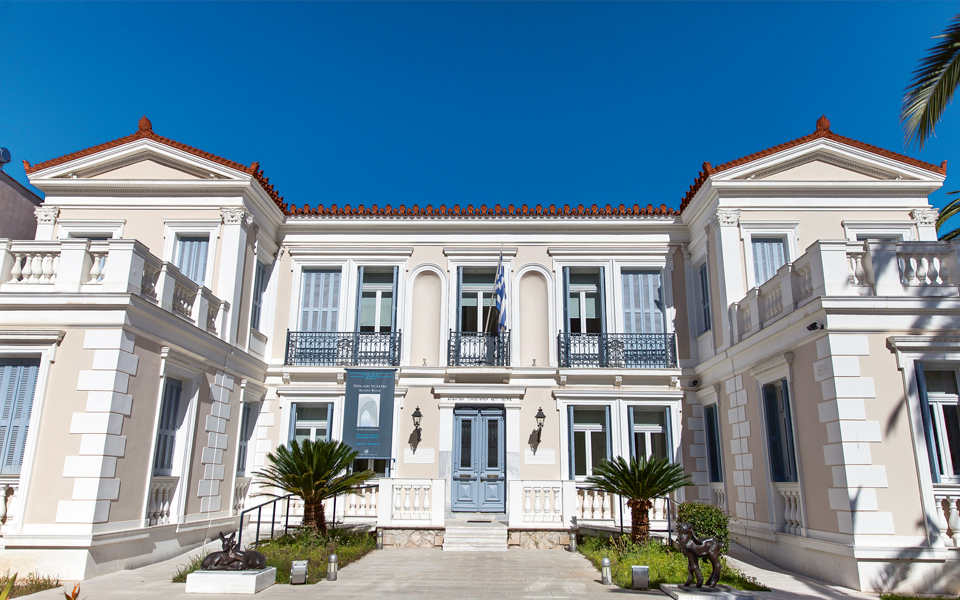
© Dimitris Vlaikos
“Moved by the Greek uprising against the Ottomans, the Russian-Armenian artist created various paintings depicting the campaign.”
NATIONAL GALLERY (NAFPLIO ANNEX)
The National Gallery’s Nafplio Annex has been housed in a listed neoclassical building on Sidiras Merarhias street since 2004. In the past, the building served as a city hospital, police unit and a taverna. The museum collection’s nucleus is focused on figures and themes linked to the Greek War of Independence against the Ottomans.
It includes paintings by Theodoros Vryzakis, Philippos Margaritis, Dionysios Tsokos, Nikolaos Gyzis and Nikiforos Lytras among others.
One of the most significant works exhibited at the gallery is a painting by Ivan Aivasowsky titled “The setting on fire of the Turkish flagship by Kanaris,” a reference to Konstantinos Kanaris, a Greek Independence hero who led a successful attack against the Turkish flagship at the harbour of Chios in 1822. Moved by the Greek uprising against the Ottomans, the Russian-Armenian artist created various paintings depicting the campaign. His painting at the Nafplio gallery depicts the Turkish ship up in flames with the vessel carrying Kanaris and his fellow fighters withdrawn in the distance.
Info | 23 Sidiras Merarhias • Tel. +30. 27520.219-15-35 • Mon, Thu, Sat: 10:00-15:00; Wed, Fri: 10:00-15:00 and 17.00-20.00; Sun: 10:00-14:00 • Closed on Tuesdays.
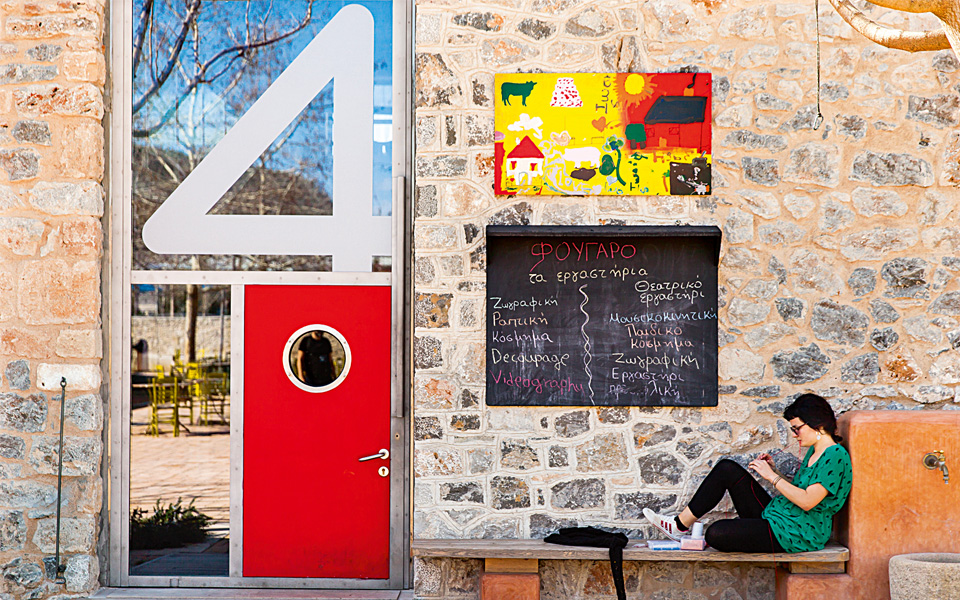
FOUGARO
This art center, created by visual artist Florika Kyriakopoulou, is housed at an impressive complex just beyond the city that once served as a canning factory named Anthos. It hosts various exhibitions, while workshops are also regularly organized with the aim of drawing the local community closer to the world of art.
Painting, jewellery making, sewing, macramé, ceramics, creative writing, videography, as well as a range of children’s programs are offered at the workshops, making them attractive for all ages. Fougaro also maintains a rich library for adults, as well as a new space for younger readers. The center’s bistro, Le Café, open from the morning hours for coffee and food, has developed into a meeting point for both locals and visitors. Jazz and rock concerts are hosted at the art center during the summer months.
Info | 98 Asklipiou • Tel. +30.27520.473.00 • Mon-Fri: 10:00-18:00 • The center’s café, art shop, and library are also open on weekends.
“Painting, jewellery making, sewing, macramé, ceramics, creative writing, videography, as well as a range of children’s programs are offered at the workshops, making them attractive for all ages.”

